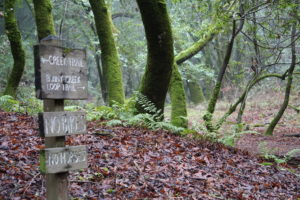
Summary:
At Hidden Villa, we have different natural habitats that plants and animals live in. These habitats are all interconnected parts of our ecosystem at Hidden Villa. You can learn a lot about a place by taking a moment to make some observations. Use your senses to look, listen and feel.
Know-It-All
Now that you have watched the videos about the different Habitats at Hidden Villa, let’s focus on some questions below. These questions have more than one correct answer and some of them will really make you think!
- What senses did Eve and Sophie use when making observations of the habitats they were in?
- What did you notice about the three different habitats? What elements were the same and what were different about them? Hint: You might want to watch the video again and take notes.
- What are the four things that every plant and animal needs to have in their habitat?
- What habitats do you have near your home or neighborhood? Notice where an animal might get food, water and shelter. What type of space is available?
- Can a farm be a habitat? Why or why not?
- What do you wonder about the habitats at Hidden Villa?
Digging Deeper
Eve and Sophie mentioned that Coyotes live in the chaparral habitat, but what other habitats do you think they could live in? Take a moment to search potential habitats on the internet.
Visit this website to learn 10 interesting things about Ecosystems: https://climatekids.nasa.gov/10-things-ecosystems/
Try It
Now let’s get creative with habitats! We hope you try out some of these fun and educational activities.
A) Create a habitat! We challenge you to draw the habitat for the following organisms. Don’t forget that every animal needs a habitat with food, shelter, water, and space. Draw a habitat for a… hawk, coyote, and a lizard.
B) Sing the Habitat Song (to the tune of Lollipop) https://youtu.be/VVPyjukPxFA Watch this video and sing along with the chorus “Habitat, Habitat. Have to have a habitat. You have to have a habitat to carry on.”
C) Create a small journal just to put your nature observations in. Once a day go outside or look out the window and make as many observations, questions, and connections as you can. After a week review all of your past notes to see how the environment around you has changed or if your observations have changed. Are you observing more details? What surprised you?
D) Read The Salamander Room by Anne Mazar or listen to it being read on YouTube: https://youtu.be/hZrtzCA9pmY . What did Brian give his salamander so it would have a complete habitat in his room?
Print out the guide by downloading the PDF
#349 Student Guide
